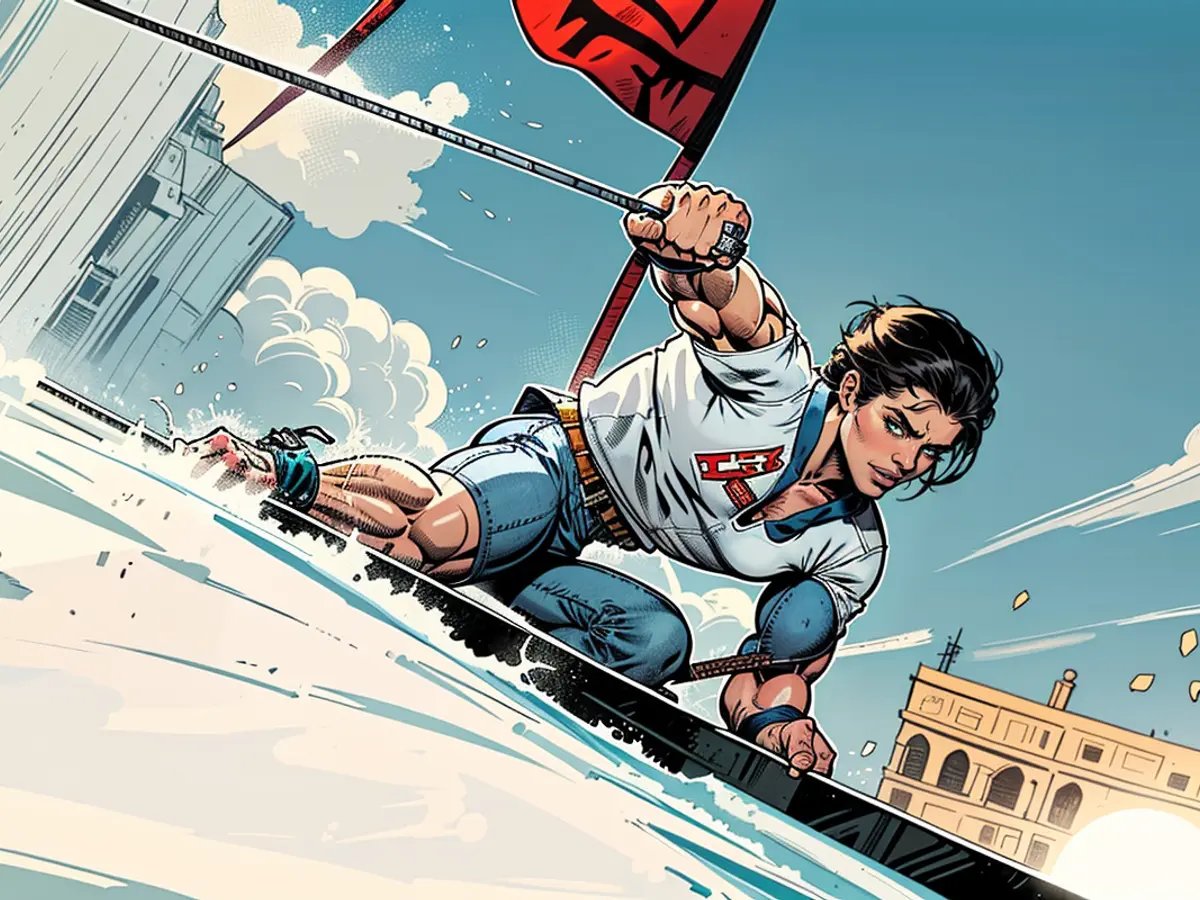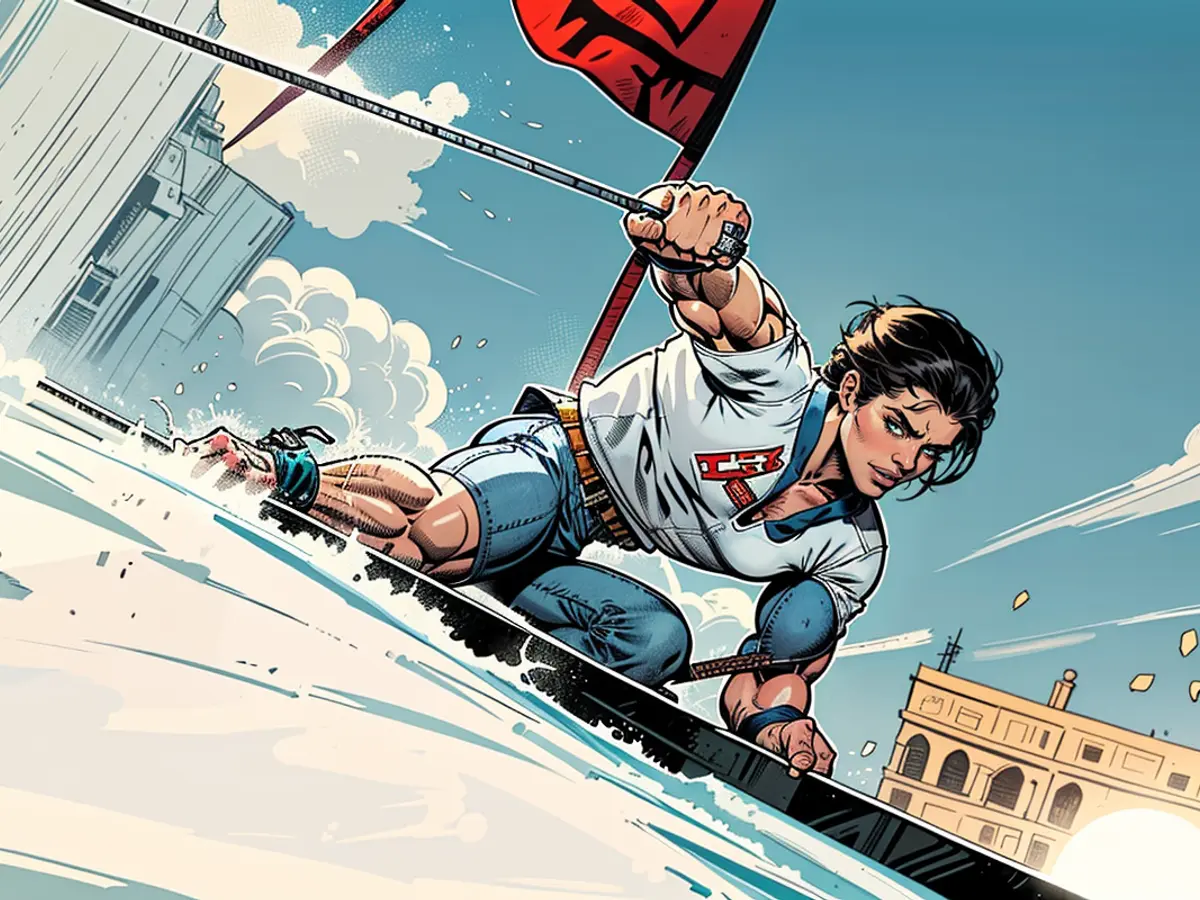This is the most exclusive site of the Olympic Games
Glimmering Sea, Life on a Ship, Far Away from the Hassle: The Surfing Women and Men Hold Their Olympic Competition 15,700 Kilometers Away from Paris. But It's Not All Idyllic, as It Seems. The Waves Are Dangerous, and the Environmentalists Protested Before the Beginning.
The view from the window promises idyll. The sun shines, the water glitters. The gymnasts Sarah Voss and Pauline Schäfer shared their view from the Olympic Village in Paris. Team Germany managed to secure a house right by the river, on the rooftop terrace, the hustle and bustle in the village on the other side can be hidden. But that doesn't change the paradise that two athletes from the German team exclusively have: Tim Elter and Camilla Kemp live during the Olympic Games 15,700 kilometers from Paris on a ship.
They represent Germany in surfing. And that takes place in Teahupo'o on Tahiti in the French Overseas Collectivity of French Polynesia. It is the exclusive venue for the Games. Surfing celebrated its premiere at the Corona Games in Tokyo only three years ago. On Tahiti, there are only two competitions, both for women and men, gold, silver, and bronze are awarded on the Shortboard.
The "Aranui 5", on which Elter, Kemp, and their competitors are accommodated, is unique at the Olympics. The ship is anchored about eight kilometers northwest of Teahupo'o. It features a tattoo parlor, eight guest decks, a spa, and a fitness room. According to the website, the ship can accommodate approximately 230 passengers. A twelve-day Pacific voyage normally costs between 3000 and 8000 Euros. During the Olympics, it remains moored - the surfing competitions take place from July 27 to 31.
Geopolitical Decision?
The way to the games in Teahupo'o is long - from the perspective of the distance to France and from the problems that the awarding of the competition to Tahiti brought. Five locations under French jurisdiction had applied: Biarritz, Lacanau, Les Landes, La Torche, and Teahupo'o. Except for Teahupo'o, all other locations were on the French mainland. "When French Polynesia applied for the organization of the surfing competitions, we were immediately fascinated by the quality of this place, this mythical wave," gushed Tony Estanguet, head of the Organizing Committee of the Games, on Polynesian television.
Geopolitics may have played a role in the decision. For several countries, Tahiti was a target of expeditions for centuries. The French explorer Louis Antoine de Bougainville reached Tahiti for the first time in 1768 and claimed the island for France. The legendary expedition of the "Bounty" also led to Tahiti, after which there was a mutiny. In the mid-19th century, France declared the island a colony, it is strategically located for military bases. Its wealth in pearls was of particular interest, as they were in high demand in Europe and Asia. France made use of slavery among the natives in the numerous French overseas territories. French Polynesia only received partial autonomy in 1977, since 2003 it is a French overseas territory. The island group is still not fully independent, since 2013 it belongs to the list of non-self-governing territories of the United Nations.
Concerns over the sensitive environment and athlete safety were set aside for the decision of the Olympic organizers. Most participants, it is said, come from North America or Oceania anyway, and would not have it that far in the South Pacific.
"Can be deadly"
The surfing competition in Teahupo'o is known for its dangerous waves. The surfers have to navigate through a passage between two reefs, where the waves can reach up to 10 meters in height. The competition is only held when the conditions are right, which can be a challenge, as the waves are unpredictable and can change rapidly. The surfers have to be in top shape and have excellent skills to master the waves. The competition is considered one of the most challenging in the world and attracts the best surfers from around the globe. The winner will be crowned the Olympic champion in surfing.
In Teahupo'o, an annual event of the World Surf League takes place, a paradise for surfers with both beautiful and dangerous waves. "It can be a wonderful experience. But it can also be life-threatening," says Kemp. "It's the strongest wave I've ever surfed. Masses of water pull you down." Kemp admits she has "partially fear" of the beast. During a training fall onto the reef, her helmet saved her from harm. Even Elder acknowledges the potential danger and illustrates what could have happened during Kemp's fall: "When one falls, the chance is quite high that one will be thrown onto the reef, get cuts, at worst, fractures or even death."
The serene appearance of the peaceful water in Elder's TikTok video from Tahiti belies the truth. There's a "monster" at the coast. The wave is referred to as a swallowing beast. It claimed a life a few years ago and is a dream for every surfer.
For 16 years, women were banned from participating in surf competitions in Teahupo'o, justified by the danger of the razor-sharp corals. Only since 2021 have they returned to the South Pacific, thanks to the lobbying efforts of scene stars like Carissa Moore or Tatiana Weston-Webb.
Discontent among the locals
As enthusiastic as Estanguet was about Teahupo'o's bid, the locals were far from pleased. "Nobody asked us," said Astrid Drollet, General Secretary of the environmental protection organization Vai ara o Teahupo'o to Deutschlandfunk. "At that time, we were neither for nor against it, because no one explained the pros and cons to us. The local population was not included in the process at home."
An inconvenience for the inhabitants, who value their nature above all and want to protect their way of life. Untouched land, crystal-clear water - that's more important than the fame the Olympic Games could bring. "It was too much for us, a major change. And that just for about a week of competitions," said Peva Levy, a member of Vai Ara o Teahupo'o, speaking to AP.
The clocks tick differently on the coast in the South Pacific than in the 15,700-kilometer-distant Paris. Although it is one of the most famous surf spots in the world, there is not a single surf shop and only one snack bar in Teahupo'o. In the bistro, there is fish that was caught in the morning. Suddenly, this huge Olympic event is supposed to intrude? The ship for the athletes is a solution, as are most other accommodations - for judges, media, etc. - in the private homes of the locals.
Planned tower in the coral reef causes outrage
But the concerns do not stop on the island. They also affect the water. "The lagoon is our refrigerator," said the 22-year-old Mormon Maitei to AP. "We get our food from it." And the - coveted by surfers - wave form could also be affected, as the reef could become rough and lose its shape, which the waves rely on for their formation. "If cracks form and it breaks apart, there will be no more waves here, it will be the end for us," so Maitei.
The excitement was even greater when it was discovered that the existing tower for judges at the coast was no longer sufficient for the games. It was built at the beginning of the 2000s from wood and had been used in all competitions since then. Suddenly, however, one was supposed to be made of aluminum, and its foundation was to be drilled into the corals. Environmentalists were appalled, fearing the destruction of the coral reefs. In October 2023, there was a protest by over 400 locals and surfers, and over 250,000 people worldwide signed a petition.
In December, fears were confirmed when a cargo ship on its way to the construction site damaged sections of the coral. A video of the damage spread on social media and caused a public outcry. In the end, compromises were made during the construction of the new tower, which is smaller and lighter than originally planned.
Everything seems to be in order for the Olympics on Tahiti now. And among some locals, the economic advantage has also won out. Homeowners like Gregory Parker can make money as landlords, just as they do during the annual stop of the Surf Tour, where they may even have to move out themselves, as he told AP. "It's not hard for two weeks," he says. "And considering the money I earn, it's worth it."
The Olympics on Tahiti are something special - not just because of the "Monster" - which the athletes experienced upon their arrival in Teahupo'o. They were welcomed by locals in a traditional ceremony and invited to celebrate the local culture and the heritage of the island. The surfers and surfers did this before all other participants at the Olympics.
Despite the Olympic Games 2024 being primarily in Paris, Germany's surfing representatives, Tim Elter and Camilla Kemp, are competing 15,700 kilometers away in Teahupo'o, Tahiti. Historically, both Germany and France have had territorial claims on Tahiti, with France officially declaring it a colony in the mid-19th century.
The environmental concerns regarding the Olympics 2024 in Teahupo'o were significant, with local environmental protection organizations like Vai ara o Teahupo'o expressing discontent. They valued the preservation of their untouched land and crystal-clear waters over the potential fame the Olympic Games could bring.









